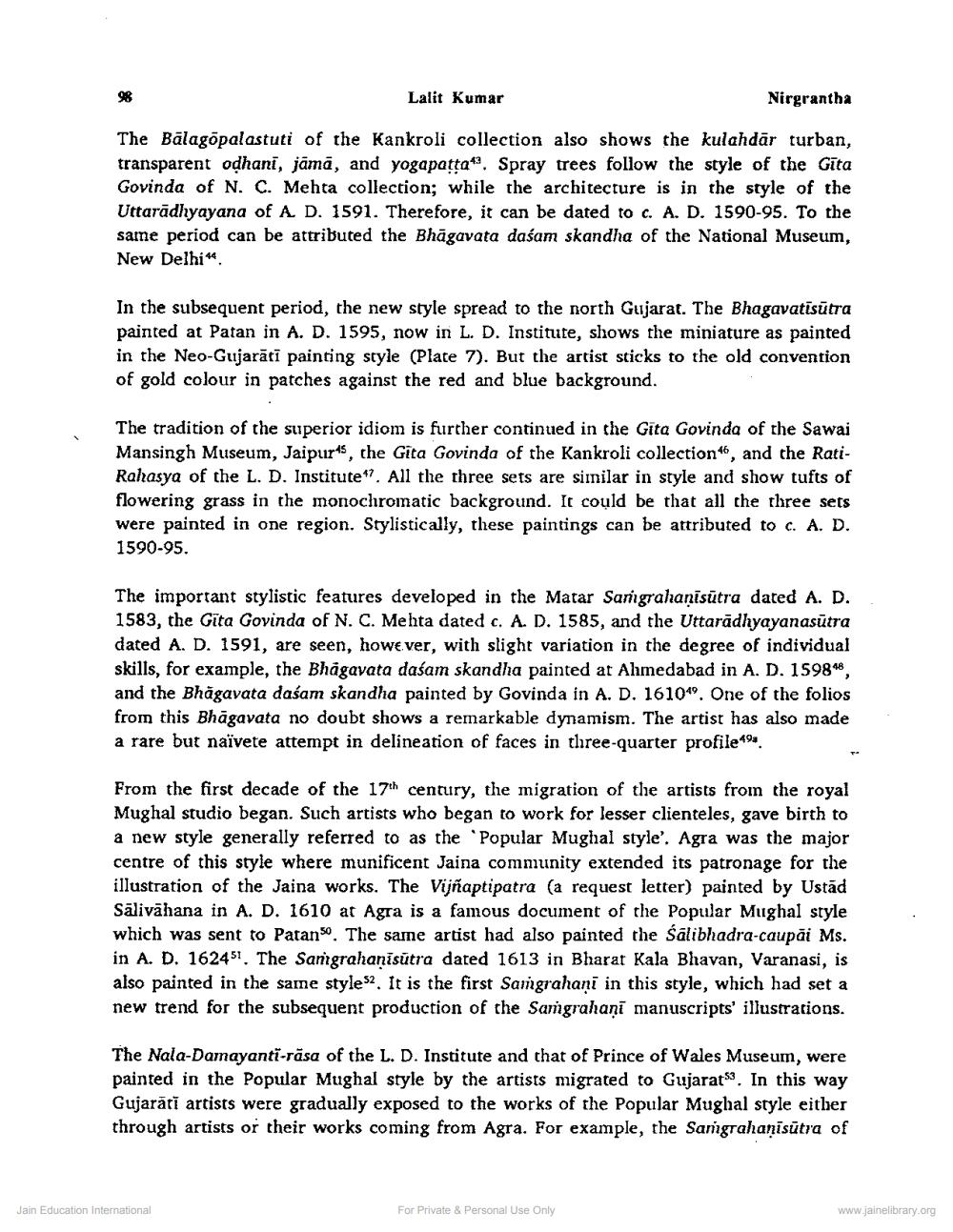Book Title: Gujarati Painting of 16th 17th Century Author(s): Lalit Kumar Publisher: Z_Nirgrantha_1_022701.pdf and Nirgrantha_2_022702.pdf and Nirgrantha_3_022703.pdf View full book textPage 7
________________ 98 Nirgrantha The Balagōpalastuti of the Kankroli collection also shows the kulahdär turban, transparent odhani, jāmā, and yogapaṭṭa". Spray trees follow the style of the Gita Govinda of N. C. Mehta collection; while the architecture is in the style of the Uttaradhyayana of A. D. 1591. Therefore, it can be dated to c. A. D. 1590-95. To the same period can be attributed the Bhāgavata dasam skandha of the National Museum, New Delhi". Lalit Kumar In the subsequent period, the new style spread to the north Gujarat. The Bhagavatisūtra painted at Patan in A. D. 1595, now in L. D. Institute, shows the miniature as painted in the Neo-Gujarati painting style (Plate 7). But the artist sticks to the old convention of gold colour in patches against the red and blue background. The tradition of the superior idiom is further continued in the Gita Govinda of the Sawai Mansingh Museum, Jaipur, the Gita Govinda of the Kankroli collection", and the RatiRahasya of the L. D. Institute. All the three sets are similar in style and show tufts of flowering grass in the monochromatic background. It could be that all the three sets were painted in one region. Stylistically, these paintings can be attributed to c. A. D. 1590-95. The important stylistic features developed in the Matar Sangrahaṇisūtra dated A. D. 1583, the Gita Govinda of N. C. Mehta dated c. A. D. 1585, and the Uttaradhyayanasutra dated A. D. 1591, are seen, however, with slight variation in the degree of individual skills, for example, the Bhagavata daśam skandha painted at Ahmedabad in A. D. 1598", and the Bhagavata dalam skandha painted by Govinda in A. D. 1610". One of the folios from this Bhāgavata no doubt shows a remarkable dynamism. The artist has also made a rare but naïvete attempt in delineation of faces in three-quarter profile". From the first decade of the 17th century, the migration of the artists from the royal Mughal studio began. Such artists who began to work for lesser clienteles, gave birth to a new style generally referred to as the 'Popular Mughal style'. Agra was the major centre of this style where munificent Jaina community extended its patronage for the illustration of the Jaina works. The Vijñaptipatra (a request letter) painted by Ustad Salivahana in A. D. 1610 at Agra is a famous document of the Popular Mughal style which was sent to Patan50. The same artist had also painted the Salibhadra-caupai Ms. in A. D. 1624. The Sangrahaṇisūtra dated 1613 in Bharat Kala Bhavan, Varanasi, is also painted in the same style. It is the first Samgrahani in this style, which had set a new trend for the subsequent production of the Sangrahani manuscripts' illustrations. The Nala-Damayanti-rāsa of the L. D. Institute and that of Prince of Wales Museum, were painted in the Popular Mughal style by the artists migrated to Gujarat. In this way Gujarāti artists were gradually exposed to the works of the Popular Mughal style either through artists or their works coming from Agra. For example, the Sangrahaṇisutra of Jain Education International For Private & Personal Use Only www.jainelibrary.orgPage Navigation
1 ... 5 6 7 8 9 10 11 12 13 14 15 16 17 18
